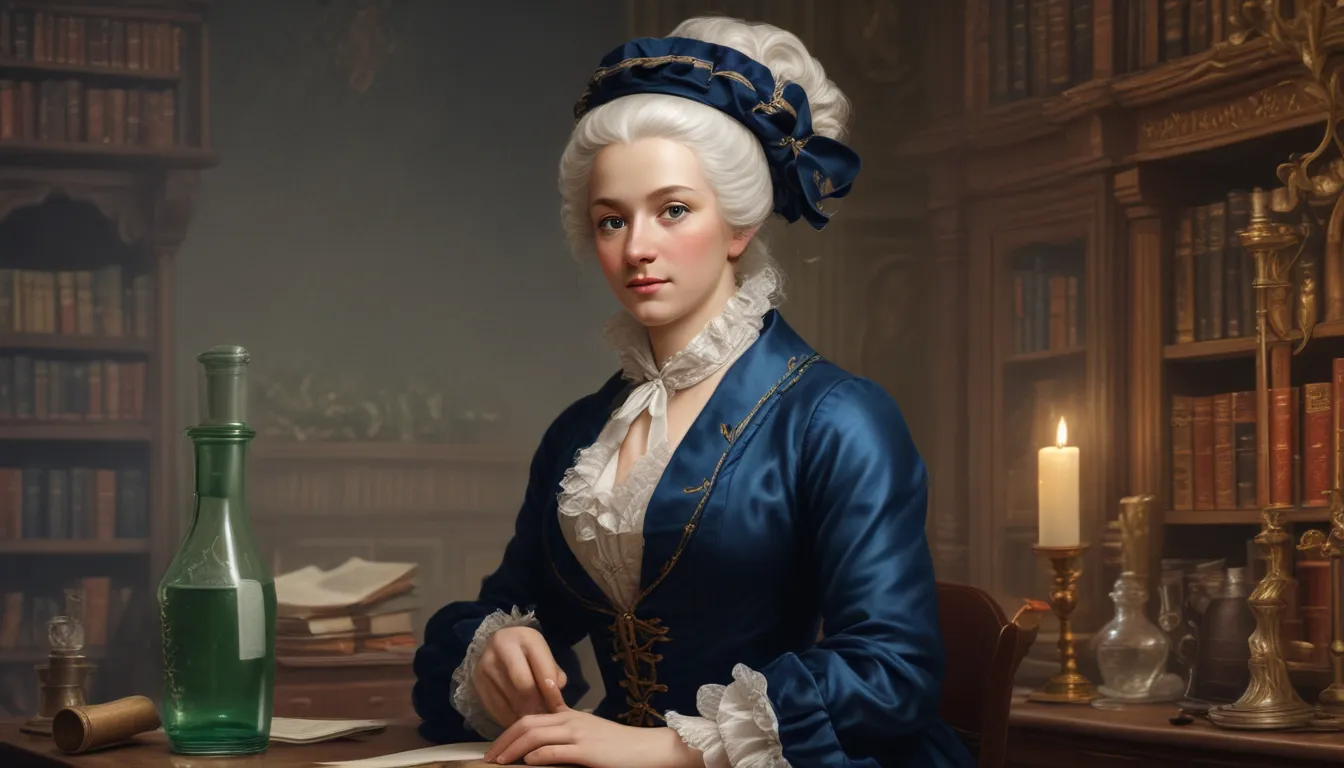The images in our articles may not match the content exactly. They are used to grab your attention, not to show the exact details in the text. The images complement the text but do not replace it.
Marie-Anne Paulze Lavoisier, often hailed as the “Mother of Modern Chemistry,” was a remarkable figure whose contributions to the scientific world have left an indelible mark. Born in 1758 in France, she was not just the wife of renowned chemist Antoine Lavoisier but also his trusted collaborator and assistant. Together, they redefined the study of chemistry and made groundbreaking discoveries that laid the foundation for contemporary chemical theory.
In this detailed exploration, we will uncover 15 mind-blowing facts about Marie-Anne Paulze Lavoisier that spotlight her intelligence, perseverance, and profound impact on the scientific community. From her exceptional talents in translation to her vital role in scientific illustrations, her story is brimming with intriguing anecdotes and accomplishments that deserve recognition and appreciation.
Unveiling Marie-Anne’s Role in Chemistry:
- Marie-Anne Paulze Lavoisier emerged as a crucial figure in shaping modern chemistry through her translations, laboratory expertise, and steadfast support for her husband’s work.
- Her significant contributions to science, art, and education have inspired future generations, particularly women, to excel in their chosen fields.
Marie-Anne’s Collaborative Endeavors with Antoine Lavoisier:
Marie-Anne Paulze Lavoisier, born in 1758, was not just merely the wife of the renowned French chemist Antoine Lavoisier but his indispensable partner. Her immense contributions to Antoine’s work played a pivotal role in shaping the foundations of modern chemistry.
The Gift of Translation:
Marie-Anne possessed a remarkable talent for languages, utilizing her skills to translate scientific texts from English into French. Her translations facilitated the dissemination of crucial scientific knowledge among French chemists, ultimately propelling the field forward.
Mastering Laboratory Techniques:
Marie-Anne’s marriage to Antoine Lavoisier granted her an in-depth understanding of laboratory techniques. Actively engaging in experiments and refining analytical methods, she significantly contributed to the accuracy and reliability of their findings.
The Artistic Touch:
Beyond her scientific prowess, Marie-Anne showcased her artistic abilities through intricate scientific illustrations. From diagrams of chemical apparatus to sketches of experiments and observations, her detailed drawings enhanced the comprehension of complex scientific concepts.
Collaborative Publications:
Marie-Anne and Antoine collaboratively authored the influential publication “Traité élémentaire de chimie” (Elementary Treatise of Chemistry). This groundbreaking work laid the groundwork for modern chemistry, introducing new principles, nomenclature, and experiments.
Preserving Scientific Legacy:
Following Antoine’s tragic execution during the French Revolution, Marie-Anne devoted herself to safeguarding his scientific legacy. Compiling his notes and manuscripts, she ensured that his revolutionary discoveries were not lost to history.
Promoting Intellectual Exchange:
Marie-Anne hosted regular gatherings at her home, attracting prominent scientists and intellectuals of her time. These gatherings served as a catalyst for intellectual exchange, nurturing scientific progress and innovation.
Advocating for Female Education:
Recognizing the significance of education for women, Marie-Anne actively supported initiatives promoting female education. Believing in the potential of women in scientific domains, she advocated for equal opportunities and recognition.
Generosity and Philanthropy:
Throughout her life, Marie-Anne used her wealth and influence to support charitable causes. Generously donating to institutions dedicated to education, scientific research, and the welfare of the less fortunate, she left a lasting impact.
Financial Management in Science:
Marie-Anne’s involvement in Antoine’s research extended beyond scientific realms. Managing the financial aspects of their work, she ensured the seamless operation of their laboratory and the procurement of essential resources for their experiments.
Active Participation in Experiments:
Marie-Anne’s commitment to scientific advancement transcended mere support as she actively engaged in chemical experiments. Conducting tests, recording observations, and analyzing results alongside Antoine, she played a crucial role in their discoveries.
Balancing Motherhood and Science:
Despite her significant contributions to the scientific realm, Marie-Anne also prioritized her role as a mother. Raising and educating her children, she instilled in them a passion for knowledge, nurturing their intellectual growth.
A Role Model for Female Scientists:
Marie-Anne’s unwavering dedication to scientific pursuits and relentless support for Antoine’s work served as a beacon of inspiration for future generations of female scientists. Her legacy continues to motivate women to shatter barriers in scientific research.
Resilience Amidst Adversity:
Surviving the tumultuous era of the French Revolution, Marie-Anne navigated political upheaval and persevered despite the challenges it presented. Her resilience allowed her to pursue her scientific endeavors amidst chaos.
Everlasting Contributions to Chemistry:
Marie-Anne Paulze Lavoisier’s contributions to the field of chemistry remain invaluable. From her translation efforts and laboratory expertise to her collaborations with Antoine Lavoisier and dedication to education and philanthropy, she has left an indelible imprint on the scientific community.
In conclusion, the captivating facts about Marie-Anne Paulze Lavoisier underscore her pivotal role in shaping modern chemistry. Her intellectual brilliance, artistic talents, and unwavering support for Antoine Lavoisier’s work secure her a prominent place in scientific history. Marie-Anne’s legacy of dedication, resilience, and pioneering spirit continues to inspire future generations of scientists, especially women, to strive for excellence in their respective fields.
Remembering a Trailblazer:
Marie-Anne Paulze Lavoisier’s pioneering work alongside Antoine Lavoisier not only revolutionized chemistry but also paved the way for future advancements in the field. Her enduring contributions amidst the turbulent backdrop of the French Revolution exemplify her resilience and commitment to science. Dive deeper into the realm of chemistry to uncover more fascinating facts awaiting your discovery.
Delve Deeper:
Our commitment to providing credible and engaging content drives us to deliver informative and trustworthy information. Each fact shared on our platform is a contribution from individuals like you, enriching our pool of diverse insights and knowledge. Rest assured, our dedicated editors rigorously review each submission to uphold the highest standards of accuracy and reliability. Explore and learn with us, trusting in our dedication to delivering quality and authentic content.
FAQs About Marie-Anne Paulze Lavoisier:
Q: Who was Marie-Anne Paulze Lavoisier?
A: Marie-Anne Paulze Lavoisier was a French chemist and artist who made significant contributions to the field of chemistry during the late 18th century. Her collaboration with Antoine Lavoisier and her work in translating and illustrating scientific texts defined her as a key figure in the scientific community.
Q: What were Marie-Anne Paulze Lavoisier’s contributions to chemistry?
A: Marie-Anne Paulze Lavoisier’s contributions to chemistry were vast and impactful. From assisting Antoine Lavoisier in conducting experiments to organizing data and translating scientific papers, she played a crucial role in the development of modern chemical nomenclature and the understanding of chemical reactions and gases.
Q: How did Marie-Anne Paulze Lavoisier impact the scientific community?
A: Marie-Anne’s translations of scientific texts were instrumental in disseminating scientific knowledge among a wider audience. Her illustrations and explanations made intricate concepts more accessible, laying the groundwork for further advancements in the realm of chemistry.
Q: Why is Marie-Anne Paulze Lavoisier an important figure in history?
A: Marie-Anne Paulze Lavoisier’s work alongside Antoine Lavoisier reshaped the field of chemistry during a period of remarkable scientific exploration. Her contributions were fundamental in paving the way for future breakthroughs in chemical analysis and comprehension.
Q: How is Marie-Anne Paulze Lavoisier remembered today?
A: Marie-Anne Paulze Lavoisier’s enduring legacy is upheld through her scientific achievements and her profound impact on the field of chemistry. A trailblazing figure in a predominantly male-dominated domain, she remains an inspirational figure for aspiring scientists across the globe.
Marie-Anne Paulze Lavoisier’s legacy transcends time, resonating with aspiring scientists and women in science. Her remarkable journey and groundbreaking achievements continue to illuminate the path for future generations of researchers and innovators. Let us honor and celebrate the remarkable contributions of this extraordinary woman.






